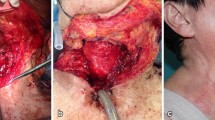Abstract
Purpose
To assess the efficacy and clinical application of a supraclavicular flap for head and neck reconstruction.
Method
A pedicled supraclavicular flap was used on 26 patients at Sun Yat-Sen University Cancer Center between July 2017 and November 2018, including 16 cases with oral cancer defects, 7 cases with laryngeal cancer and hypopharyngeal carcinoma defects, 1 case with parotid gland cancer defects, 1 case with external auditory canal cancer defects, and 1 case with tracheal esophageal fistula. The time required to harvest the flap, the amount of intraoperative blood loss, the duration of postoperative drainage tube placement, the outcome of the flap, and the healing observed at the donor site are reported.
Result
The sizes of the flaps were 6–20 × 4–6.5 cm. The time required to harvest the supraclavicular flap ranged from 25 to 35 min and averaged 30 min. The amount of intraoperative blood loss ranged from 20 to 100 ml and averaged 58.8 ml. The duration of postoperative drainage tube placement ranged from 3 to 8 days and averaged 5.9 days. A total of 23 flaps survived. In two cases, the distal blood supply of the flaps was poor, but the flaps survived after debridement and suturing. One flap had partial necrosis, but survived after conservative treatment. All donor area defects were directly sewed and stitched without complications.
Conclusion
There are multiple advantages of the supraclavicular flap, including simple preparation technique, reliable repair of the defects, and without the need for performing microvascular anastomosis. It can be safely used in head and neck reconstruction after surgery.

Similar content being viewed by others
References
Zou X, Wang SL, Liu YP et al (2018) A curative-intent endoscopic surgery for postradiation nasopharyngeal necrosis in patients with nasopharyngeal carcinoma. Cancer Commun (Lond) 38(1):74
Park CW, Miles BA (2011) The expanding role of the anterolateral thigh free flap in head and neck reconstruction. Curr Opin Otolaryngol Head Neck Surg 19(4):263–268
Cordova A, D’Arpa S, Pirrello R et al (2009) Anatomic study on the transverse cervical vessels perforators in the lateral triangle of the neck and harvest of a new flap: the free supraclavicular transverse cervical artery perforator flap. Surg Radiol Anat 31(2):93–100
Sandu K, Monnier P, Pasche P (2012) Supraclavicular flap in head and neck reconstruction: experience in 50 consecutive patients. Eur Arch Otorhinolaryngol 269(4):1261–1267
Lamberty BG (1979) The supra-clavicular axial patterned flap. Br J Plast Surg 32(3):207–212
Pallua N, Machens HG, Rennekampff O et al (1997) The fasciocutaneous supraclavicular artery island flap for releasing postburn mentosternal contractures. Plast Reconstr Surg 99(7):1878–1884 (discussion 1885–6)
Chiu ES, Liu PH, Friedlander PL (2009) Supraclavicular artery island flap for head and neck oncologic reconstruction: indications, complications, and outcomes. Plast Reconstr Surg 124(1):115–123
Bin Z et al (2015) Clinical experience with the supraclavicular flap to reconstruct head and neck defects. Chin J Otorhinolaryngol Head Neck Surg 6:468–472
Wen Y, Wen W, Wang Z et al (2018) Clinical application of supraclavicular flap for oncologic reconstruction of hypopharynx and upper esophagus. Chin J Otorhinolaryngol Head Neck Surg 1:16–20
Giordano L, Di Santo D, Occhini A et al (2016) Supraclavicular artery island flap (SCAIF): a rising opportunity for head and neck reconstruction. Eur Arch Otorhinolaryngol 273(12):4403–4412
Atallah S, Guth A, Chabolle F et al (2015) Supraclavicular artery island flap in head and neck reconstruction. Eur Ann Otorhinolaryngol Head Neck Dis 132(5):291–294
**ao-zhi L, Ting-ru S, Meng Z (2016) Reconstruction of defects with supraclavicular artery island flap following ablation of tongue squamous cell carcinoma. J Dent Prev Treat 7:386–389
Kokot N, Mazhar K, Reder LS et al (2013) The supraclavicular artery island flap in head and neck reconstruction: applications and limitations. JAMA Otolaryngol Head Neck Surg 139(11):1247–1255
Chen S, Yao X, Lu Z et al (2017) Clinical study of the reconstruction of the defect of maxillofacial region with the supraclavicular artery island flap. Chin J Stomatol Res (Electron Ed) 11(2):106–110
Zhang D, Chen W, Chai Q et al (2011) Reconstruction of tongue defects following oral cancer ablation with extended supraclavicular fasciocutaneous island flap. Chin J Stomatol 1:24–26
Herr MW, Bonanno A, Montalbano LA et al (2014) Shoulder function following reconstruction with the supraclavicular artery island flap. Laryngoscope 124(11):2478–2483
Funding
The study has been supported and funded by National Natural Science Foundation of China (Grant No. 81572657) for laryngeal carcinoma.
Author information
Authors and Affiliations
Corresponding author
Ethics declarations
Conflict of interest
The authors declare that they have no conflict of interest.
Sponsorships
None.
Research involving human participants and/or animals
All procedures performed in studies involving human participants were in accordance with the ethical standards of the institutional and/or national research committee and with the 1964 Helsinki declaration and its later amendments or comparable ethical standards.
Informed consent
Informed consent was obtained from all individual participants included in the study.
Additional information
Publisher's Note
Springer Nature remains neutral with regard to jurisdictional claims in published maps and institutional affiliations.
Rights and permissions
About this article
Cite this article
Li, Y., Zhao, Z., Wu, D. et al. Clinical application of supraclavicular flap for head and neck reconstruction. Eur Arch Otorhinolaryngol 276, 2319–2324 (2019). https://doi.org/10.1007/s00405-019-05483-9
Received:
Accepted:
Published:
Issue Date:
DOI: https://doi.org/10.1007/s00405-019-05483-9




